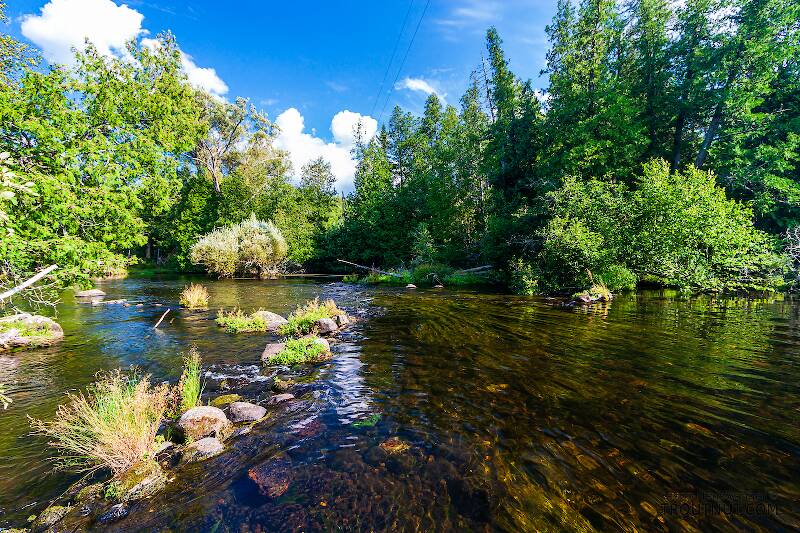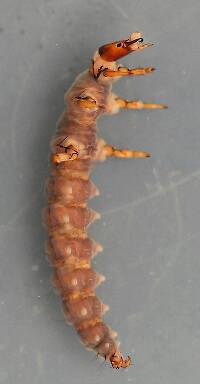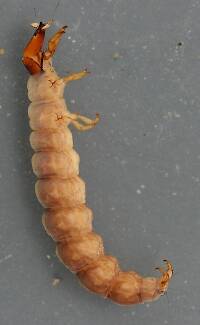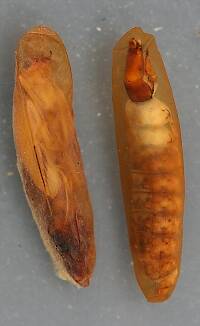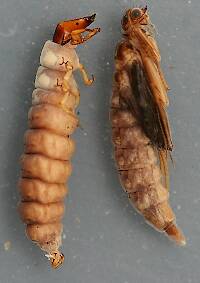
Hex Mayflies
Hexagenia limbata
The famous nocturnal Hex hatch of the Midwest (and a few other lucky locations) stirs to the surface mythically large brown trout that only touch streamers for the rest of the year.
Featured on the forum

This one was surprisingly straightforward to identify. The lack of a sclerite at the base of the lateral hump narrows the field quite a bit, and the other options followed fairly obvious characteristics to Clostoeca, which only has one species, Clostoeca disjuncta.

Troutnut is a project started in 2003 by salmonid ecologist Jason "Troutnut" Neuswanger to help anglers and
fly tyers unabashedly embrace the entomological side of the sport. Learn more about Troutnut or
support the project for an enhanced experience here.
754cromero has attached this picture to aid in identification. The message is below.
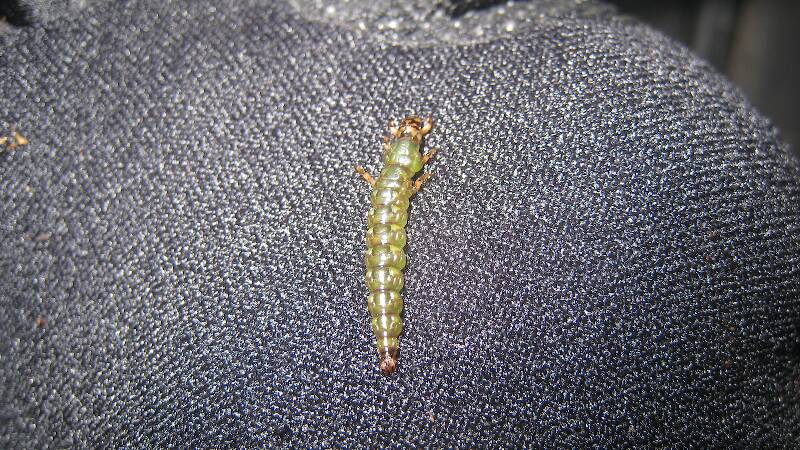
754cromero
Posts: 2
Posts: 2
754cromero on Feb 3, 2013February 3rd, 2013, 6:50 pm EST
Seeing some of the great pictures on this website, I wish I had something better than a point-and-shoot to take the pictures I did. That said, I'm not looking for a species identification, but just want to make sure I'm on the right track (Order or Family is good enough for me) of identifying this insect. The only thing I can imagine this being is a hellgrammite, but it still doesn't have all the spines I'd think of with a hellgrammite. (So, if others concur it is a hellgrammite, why does it not have the spines? age? species?)
Other info: it is about 1 inch long, and crawled onto my waders in the Smith River in Virginia.
Thanks.
Other info: it is about 1 inch long, and crawled onto my waders in the Smith River in Virginia.
Thanks.
Creno on Feb 3, 2013February 3rd, 2013, 8:10 pm EST
Howdy - this is indeed a larvae - one of the many free-living Rhyacophila species. Probably one of the R. fuscula group but I cannot see enough of the head/thorax color pattern to be sure about which species.
PaulRoberts on Feb 4, 2013February 4th, 2013, 5:56 am EST
Look up Rhyacophila in Google images and ... off you go: ID, habitat, habits, fly patterns, etc... . Start by searching this site for a lot of great images and discussion about Rhyacophila or just about anything else you could find clinging to your waders or in a trout's stomach.
BTW: Welcome.
BTW: Welcome.
Oldredbarn on Feb 4, 2013February 4th, 2013, 6:14 am EST
I love this site! Where else can a newbie post an iquiry and have Dave answer it?! Our own favorite caddis bug guy...:) Thanks sir!
Welcome cromero! That is a nice photo from a tyers standpoint...Dave is a pro and, as he said, would need more to id to species for you...Close enough if you ask me...I could see a gold bead head with a light olive/celery colored body...
You can see why the trout find these critters yummy...That is a good bit of protein for a fish.
Anglers...If you are mayfly-opic you are missing the boat...A trout can munch on these all day and never have to visit the dangerous surface and there would be nary a buldge to give him away...Can you spell, "searching fly"? ;)
Those steelheaders already know this...See www.defranksflies.com Check out his Kazulen's Caddis.
Spence
...and then Paul Robert's to boot! :)
Welcome cromero! That is a nice photo from a tyers standpoint...Dave is a pro and, as he said, would need more to id to species for you...Close enough if you ask me...I could see a gold bead head with a light olive/celery colored body...
You can see why the trout find these critters yummy...That is a good bit of protein for a fish.
Anglers...If you are mayfly-opic you are missing the boat...A trout can munch on these all day and never have to visit the dangerous surface and there would be nary a buldge to give him away...Can you spell, "searching fly"? ;)
Those steelheaders already know this...See www.defranksflies.com Check out his Kazulen's Caddis.
Spence
...and then Paul Robert's to boot! :)
"Even when my best efforts fail it's a satisfying challenge, and that, after all, is the essence of fly fishing." -Chauncy Lively
"Envy not the man who lives beside the river, but the man the river flows through." Joseph T Heywood
"Envy not the man who lives beside the river, but the man the river flows through." Joseph T Heywood
754cromero
Posts: 2
Posts: 2
754cromero on Feb 6, 2013February 6th, 2013, 11:37 am EST
Thanks for the quick and courteous replies! I did fall in to the trap of thinking (all) caddisflies built shelters.
Thanks again,
Charles
Thanks again,
Charles
Jmd123 on Feb 7, 2013February 7th, 2013, 1:28 pm EST
I believe this specimen is typical of what many fly fisherman refer to as a "green rock worm", and there are many good fly patterns to imitate this group of species. Confirmation from Spence or others? Also, these are net-spinners, no?
Welcome to the forum, Charles! You'll find plenty of "bug-nuts" on this site. (Perhaps it should be called "bugnut.com" instead??...at least the way all of the posts are going as of late - not too many of us are out fly fishing so we gotta do something else...)
;oD
Jonathon
Welcome to the forum, Charles! You'll find plenty of "bug-nuts" on this site. (Perhaps it should be called "bugnut.com" instead??...at least the way all of the posts are going as of late - not too many of us are out fly fishing so we gotta do something else...)
;oD
Jonathon
No matter how big the one you just caught is, there's always a bigger one out there somewhere...
Taxon on Feb 7, 2013February 7th, 2013, 3:04 pm EST
Jonathan,
Net spinners are in superfamily Hydropsychoidae and look more like this:
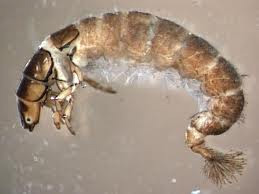
Also, these are net-spinners, no?
Net spinners are in superfamily Hydropsychoidae and look more like this:

Jmd123 on Feb 8, 2013February 8th, 2013, 8:46 am EST
I thought I was wrong - thanks for correcting me. What do these "green rock worms" eat, are they predacious? Guess I could go look it up in Gary Lafontaine's "Caddisflies", I do have a copy...
Jonathon
Jonathon
No matter how big the one you just caught is, there's always a bigger one out there somewhere...
Oldredbarn on Feb 8, 2013February 8th, 2013, 9:39 am EST
are they predacious?
Yes...They have a fondness for black fly larvae...Yum! No? :(
Spence
"Even when my best efforts fail it's a satisfying challenge, and that, after all, is the essence of fly fishing." -Chauncy Lively
"Envy not the man who lives beside the river, but the man the river flows through." Joseph T Heywood
"Envy not the man who lives beside the river, but the man the river flows through." Joseph T Heywood
Taxon on Feb 8, 2013February 8th, 2013, 9:46 am EST
Hi Jonathan-
Yes, primarily. Among the (~126) Rhyacophila species are predators (engulfers), a few scrapers, collecter-gatherers, shreders-herbivors (chewers) per Glen B. Wiggins.
What do these "green rock worms" eat, are they predacious?
Yes, primarily. Among the (~126) Rhyacophila species are predators (engulfers), a few scrapers, collecter-gatherers, shreders-herbivors (chewers) per Glen B. Wiggins.
Quick Reply
Related Discussions
Topic
Replies
Last Reply
1
May 17, 2016
by Bnorikane
by Bnorikane
1
Aug 24, 2006
by Troutnut
by Troutnut
0
Apr 12, 2007
by Litobrancha
by Litobrancha

